Understanding Bauxite Sand Composition, Uses, and Environmental Impact
Bauxite sand is a naturally occurring material that plays a crucial role in the production of aluminum. Comprised primarily of aluminum oxide minerals, bauxite is the principal ore from which aluminum is extracted. Bauxite sand, characterized by its fine, granular texture, is often found in areas with significant bauxite deposits. Understanding its composition, uses, and potential environmental impacts is essential for industries reliant on aluminum production.
Composition of Bauxite Sand
Bauxite sand primarily contains aluminum-bearing minerals, including gibbsite, boehmite, and diaspore. These minerals form through the weathering of aluminum-rich rocks. While the exact composition can vary, the sand typically contains around 30-60% alumina (Al2O3), along with other oxides such as iron oxide (Fe2O3), silica (SiO2), and titanium dioxide (TiO2). The presence of iron gives bauxite its reddish-brown color, while silica contributes to its physical characteristics.
The exploration and extraction of bauxite sand require an understanding of geological formations and the sedimentary processes that contribute to its development. Mining companies often rely on geological surveys to identify high-quality deposits that are economically viable to extract.
Uses of Bauxite Sand
The primary use of bauxite sand is in the aluminum production process. Upon extraction, bauxite is refined to produce alumina, which is then subjected to electrolysis to obtain aluminum metal. Aluminum is a highly valuable material used across numerous industries, including manufacturing, construction, transportation, and packaging. Its lightweight properties, corrosion resistance, and recyclability make it an ideal choice for a wide range of applications, from aircraft components to beverage cans.
bauxite sand

In addition to aluminum production, bauxite sand can also serve as an abrasive material due to its hardness. It can be used in sandblasting and as an aggregate in various construction applications. Moreover, researchers are exploring the potential of bauxite sand in the production of high-performance ceramics and composites, opening new avenues for innovation.
Environmental Impact
While the extraction and utilization of bauxite sand bring significant economic benefits, they also raise important environmental concerns. Mining operations can lead to deforestation, habitat destruction, and soil degradation. The process of refining bauxite into alumina generates a byproduct known as red mud, which poses disposal challenges due to its caustic nature and potential to contaminate local water sources.
To mitigate these impacts, many companies are adopting more sustainable practices, including land reclamation efforts and waste management strategies. The development of alternative technologies, such as recycling aluminum, can also help reduce the demand for newly mined bauxite, thereby minimizing its environmental footprint.
Conclusion
Bauxite sand is a vital resource in the global aluminum industry, recognized for its unique composition and various applications. Its extraction and processing, however, necessitate a careful consideration of environmental implications. Striking a balance between industrial growth and ecological preservation is essential for ensuring that future generations can benefit from this important mineral resource. As the demand for aluminum continues to rise, the industry must prioritize sustainable practices to safeguard the environment while meeting the needs of society. By integrating innovative solutions and fostering responsible mining practices, we can ensure a more sustainable future for both bauxite sand utilization and the broader ecological landscape.
Post time:nov. . 08, 2024 09:49
Next:Top Sand Casting Manufacturers for High-Quality Industrial Solutions and Innovations
